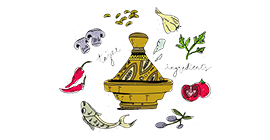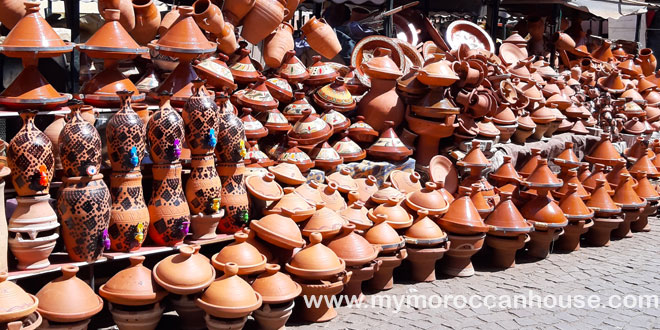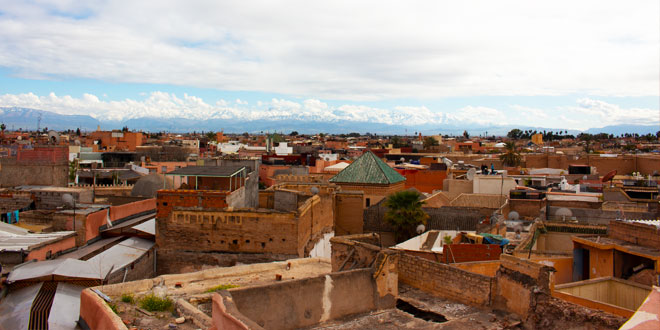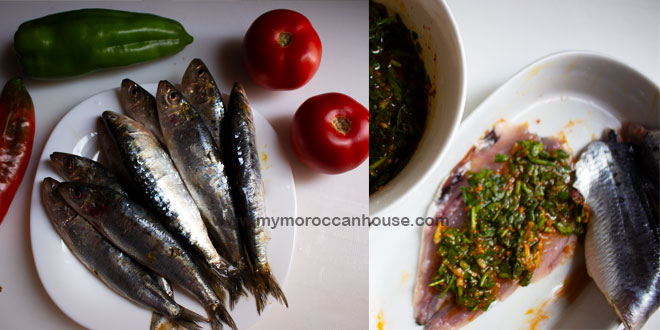You have reached this interesting post as you might be among those who have asked the following questions: How Long to Steep Moroccan Mint Tea is Moroccan mint the same as peppermint? Is Moroccan mint tea a green tea? Is Moroccan mint tea served hot or cold? Why is Moroccan tea poured from a height? What tea do Moroccans drink? if so, you have come to the right place.
How Long to Steep Moroccan Mint Tea?
The food of Morocco is rich, delicious, and colorful. Moroccan food has a vast collection of small plates offering fresh and cooked salads that begin or accompany meals to the delicate sweetmeats and, inevitably, mint tea.
Moroccan tea is prepared in, and served from, a spouted teapot, or as we call it in Morocco ” Berrad”. Teapots range from plain aluminum or enameled metal to etched stainless steel with small “feet.” Tea glasses tend to be tiny and ornately decorated.
Mint tea is consumed throughout the day. We consider mint tea to be indispensable to satisfy our thirst, especially during summertime, it is also the drink of hospitality that we offer to our guests or to people passing through.
Moroccan mint tea should be steeped for at least 2 to 3 minutes. When we add the mint leaves, we drown them at the bottom of the teapot right away. The mint leaves should not float and cook as this gives a bitter burnt taste. after that, we add sugar cubes and leave to steep or infuse for two or three minutes.
Is Moroccan Mint the Same as Peppermint?
Moroccan mint is not the same as peppermint. However, you can absolutely cook Moroccan tea with fresh or dried herbs of your taste including peppermint.
As a whole, Moroccan mint is a perennial plant with a sweet, vigorous, and pleasant scent. If you want to successfully dry mint, you had to cut the stems in summer and then hang them in a dry, dark warm place. After three or four weeks, the stems are stripped and then stored in opaque, airtight containers or plastic bags. To best preserve the fragrance, the mint must be reaped before flowering, when the essences are most concentrated.
Mint species are very numerous, many are cultivated as aromatic, ornamental, or medicinal plants. Green mint tea is widely used as an aromatic herb.
Similarly, we use absinthe as a substitute for mint in Moroccan tea, particularly during wintertime. We call absinthe in Moroccan Arabic “Shiba” and if you are not familiar with it it is sprigs of pale, silvery plant, with delicate, fine leaves that hint of anise.
We Moroccan love to add Shiba or absinthe to mint tea in winter to reinforce the flavor and add a bit of warmth. We usually the leaves at the end of the preparation and infuse or steep for 30 seconds to 1 minute, as the flavor quickly becomes vigorously bitter. Some Moroccan families also would prefer to combine absinthe with dried rosebuds for a cold-weather infusion.
Is Moroccan Mint Tea a Green Tea?
Yes, Moroccan mint tea is green tea. The basis of mint tea is green tea called gunpowder. Mint is undoubtedly the herb most associated with Morocco.
If you are not in Morocco, you can make delicious Moroccan mint tea very easily as there exist a variety of mint-flavored green teas with Moroccan flavors to infuse directly in bulk or in sachets.
Moroccan prefer the narrow, brilliant green leaves of fresh Moroccan spearmint, which is sold and used in great quantities across Morocco.
Is Moroccan Mint Tea Served Hot or Cold?
Moroccan tea is a way of life and a philosophy. Moroccan mint green tea is always served very hot. We make Moroccan mint tea to accompany delicious dishes both for breakfast and for an afternoon break.
Moroccan tea is a very sweet mint-flavored green tea.
The best green tea for Moroccan mint tea is gunpowder. To make an excellent tea, yet there are variations to the recipe, the basic method remains the same:
- green tea
- fresh mint, usually “Nanah” mint from Morocco. In winter, when it is not the mint season, it can be replaced by absinthe leaves, which are more bitter
- sugar
- hot water
The preparation of mint tea, mainly done by men in front of the guests, is quite an art.
After cleaning the green tea with boiling water inside the teapot, add fresh mint, sugar and water. Then, let everything steeped or infused for at leat 2 to 3 minutes.
The tea is then poured into glasses at a height in order to make foam on the surface to aerate the tea and exalt the flavors even more.
In addition to its naturally refreshing taste, Moroccan mint tea has medicinal virtues, particularly toning, and digestive benefits.
Why Is Moroccan Tea Poured from A Height?
Moroccan mint tea is poured from a height in order to make the flavors merge together, to aerate the tea, to produce the foam on the surface the fact that exalts all the savors even more.
Moroccans usually respect a certain height between the spout of the teapot and the glass to pour it back into the teapot. They practice this as many times as necessary before serving themselves.
What Tea Do Moroccans Drink?
Fresh mint usually flavors pots of Moroccan green tea, yet other herbs can be used, such as oregano, zaâtar in Moroccan Arabic, and saffron. Saffron is an important crop around Taliouine on the high Souktana plateau, where the fragrant flower stigmas season many dishes and also lace tea.
Rinsing the leaves in the pot with boiling water first removes some of the bitterness of the tea. This is an authentic and easy Moroccan mint tea you can try:
Moroccan mint tea recipe:
- Preparation time: 10 minutes
- Cooking time: 10 minutes
- Number of people: 4
Ingredients :
- 3 to 4 teaspoons of green tea – prefer good quality and Gunpowder type teas
- 1 bunch of fragrant fresh mint (preferably organic Nanah from Morocco)
- 1.5 L of water
- Sugar stones (allow 10 pieces minimum) or pieces of sugar loaf
- Moroccan mint green tea
Preparation :
Wash the bunch of fresh mint. Carefully remove the mint leaves.
In a ketlle, bring the 1.5L of water to a boil.
In a bowl, place your 4 to 5 teaspoons of green tea and pour the equivalent of a glass of boiling water over it to “rinse” the tea. Discard the infused water after 3 minutes. This process eliminates excess tannin and removes the bitterness of the tea.
Put your green tea in a teapot. you can use a filter teapot with a spout to facilitate the service
Pour the remaining boiling water over the green tea.
Then add the mint leaves, drowning them at the bottom of the teapot right away, they should not float and cook this gives a bitter “burnt” taste to be avoided.
Add the sugar cubes.
Leave to infuse for 2 or 3 minutes.
Mix your mixture. Be careful, do not use a spoon but pour the beverage into a glass and pour it back into the teapot. By repeating the operation several times, your tea will be homogeneous and airy and will be able to deliver all its flavor.
You may want to taste your mixture to adjust the sugar according to your preferences.
Serve high and hot.
Conclusion
The number one of the Moroccan beverages is, undoubtedly, Mint Tea. Brewed in teapots and served in small glasses, tea is invariably sweet. In winter, when mint tends to be at its weakest, many add to the pot other fresh herbs, such as absinthe, oregano, saffron, marjoram, or verbena.
Customarily brewed in and served from a silver teapot called in Moroccan dialect “berrad”, the tea is poured into short, often ornate tea glasses from well above the glass. A scientific explanation might be that this practice reoxygenates the water, which was flattened in the process of boiling.
At breakfast, you can accompany your Moroccan tea with Moroccan bread ” khobz”, fresh dates, olives, and scrambled eggs.
At tea time, you can serve it with Moroccan pastries such as Ghriyba, Fekkas, makroud, gazelle horns.
What Is so Special About Morocco? Reasons Why You Should Visit Morocco
Morocco is a land of glamorous and vivid contrasts. The gateway to two continents, it is a country of breathtaking landscapes, rich in history and heady with magnific scents and spectacular sights.
While the countryside is home to old traditions and diverse peoples, the ever-growing urban centers boast incredible new architecture together with the old, and activities to suit all modern tastes.
Morocco’s diverse geography, multicultural atmosphere, and rich history make it a mesmerizing country.
Its towns offer a striking contrast of ancient kasbahs, mosques and souks and modern architecture, with a
mix of Berber, Arab and African peoples.
In the crowded ancient medinas, young men in designer jeans haggle over cell phones alongside traditionally dressed women shopping for housewares.
In the fertile countryside, a farmer riding on a goat is as common a sight as a television satellite perched on a mud-brick roof.
Moroccan culture is extremely rich and difficult to pigeonhole. Moroccan landscape includes beaches, mountains, lakes, forests, and deserts.
Morocco is a unique blend of Arab, African, and European ways of life, and the Moroccans wouldn’t have it any other way.
Moroccan cuisine is rich and varied, owing to a variety of cultural influences. Meat is well-spiced and lean, vegetables are fresh and abundant, and everything is permeated with spices.
Moroccan cooking is quite labor-intensive and dishes are pleasingly presented as well as meticulously prepared.
Beef, lamb, fish, and chicken are all popular and used in a variety of dishes. Pigeon and turkey are also available, and the seafood in the coastal cities is not to be missed.
Meat is prepared according to Islamic halal regulations.
Rice, semolina wheat, and barley grains are used for a variety of dishes. A wide range of spices is used, including cumin, saffron, paprika, ginger, cinnamon, red and black pepper, and a special mixture called ras al-hanout is widely used in Moroccan cuisine.
A typical Moroccan meal starts with something fresh or cooked salads, olives and pickled vegetables and bread, and sometimes a cold beverage. The main course is then brought out, usually in a large pot, or tajine.
Moroccans will either eat from the main dish with their hands or using spoons, or serve food on to individual dishes.
After the main course is through and plates are removed, various fruits are arranged on the table, and mint tea is served, sometimes with Moroccan cookies.



